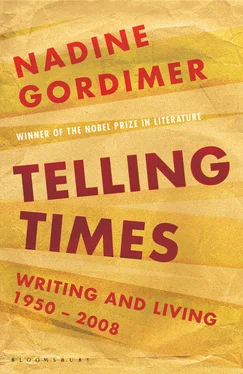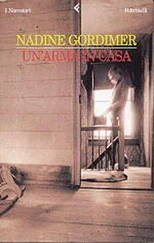Robert and I slipped away from the rest of the family — I was extremely anxious to have this adventure exclusive of my sister — and in half an hour the engineer had Robert, me, and Robert’s movie camera in his truck. While the wild passage of the truck through water and mud shook loose every nerve in our bodies, he told us that what we were going to do was perfectly safe, and then, almost in the same breath, that what we were going to do was terribly dangerous but that we need not worry, for he knew exactly how to do it and get away with it. I wanted to close my eves with the speed and exhilaration, but the leaps of a herd of impala deer that we had startled into a Nijinsky-like retreat of alarmed grace brought me out of my tense passivity almost as abruptly as the deer had been brought out of theirs. After about twenty minutes, we reached a river bed, and there, with their great columns of legs in the newly flowing water, stood three magnificent elephants.
The shattering life of the truck came to an abrupt halt. The engineer said ‘There you are!’, and sent Robert and me stalking on foot. It seemed as if our hush of intensity had brought home to the engineer his boredom with this sort of adventure; he looked around for a dry boulder where he could sit and smoke his pipe while he waited. The truck was, I suppose, about two hundred yards from the river. When Robert and I were very near indeed to the elephants, and the beetle-wing whir of the camera was sounding, one of the great beasts slowly swung his head erect and towards us. Then he walked out of the shallow water, trailing his huge feet like a clumsy child, and advanced to within thirty feet of the camera, Robert, and me. And there the elephant stood, slowly flapping those wide, palmetto-like ears that African elephants have. I don’t think he seemed real to us; we thought only of the camera, and saw the elephant as he would loom on the screen rather than as he was, a slack-skinned splendid hulk, standing there before us. Then, all in the same instant, I smelled liquorice tobacco and felt myself violently grasped by the arm. The same thing must have happened to Robert, for at once we were jerked furiously around, met the impatient and alarmed face of the engineer, and were running, pushed roughly along by him, for the truck. I suppose it was the beating of my own heart that I thought was the pounding of the elephant coming up behind us.
Driving back to Shingwedsi camp, the engineer grinned fascinatingly — it was difficult to say who was more under the spell of that grin, Robert or me — and remarked, ‘Those pictures will be quite good enough as it is. You don’t want to scare your friends, do you?’ And Robert and I laughed, to show that we, too, knew there hadn’t really been any danger. It was only next day, when our party had moved on to Pretorius Kop camp to see lions, that I suddenly remembered that the engineer hadn’t had to start the truck when we jumped in; he had left the engine running all the time. Some years later, I was told that there is reason to believe that when an elephant flaps his ears, he does it to fan the scent of his enemy more strongly towards his nostrils, in preparation for a charge.
In a country where people of a colour different from your own are neither in the majority nor the ruling class, you may avoid altogether certain complications that might otherwise arise in the formation of your sense of human values. If the Chinese, say, remain a small, exiled community in Chinatown, and the Red Indians are self-contained on their reservation, you can grow up to have a reasonable standard of personal ethics without taking consideration of their presence. The problem of how you would behave towards them if you met them can be almost purely academic; you need not meet them, if you don’t wish to. In South Africa, this is not possible. There are people who try it, who arrange their lives for it, but they never succeed, for it cannot be done. Even if you are the most diehard reactionary, you cannot get away with it in a country where there are three million white people and nine million black and coloured.
For me, one of the confusing things about growing up in South Africa was the strange shift — every year or two when I was small, and then weekly, daily almost, when I was adolescent — in my consciousness of, and attitude towards, the Africans around me. I became aware of them incredibly slowly, it now seems, as if with some faculty that should naturally, the way the ability to focus and to recognise voices comes to a baby in a matter of weeks after birth, have been part of my human equipment from the beginning. The experience of the warm black bosom of the mammy (in South Africa she would be known as the nanny) has been so sentimentalised that I must say I am glad it is one I missed, though not for the reason that I missed it. The reason was simply that my mother, like many good South African mothers from England and Europe, would not have dreamed of allowing any child of hers to nestle in the bosom of a dirty native girl. (That was exactly the phrase — a phrase of scornful reflection on those mothers who did.) And if, at the age of five or six, it had been suggested to my sister or me that we should go up and give our native servant a hug, we would have shrunk away. We accepted the fact that natives were not as clean as we were in the same way we accepted the fact that our spaniel had fleas. It was not until years later that it occurred to me that if our servants were not so well and frequently bathed as ourselves, the circumstance that no bathroom or shower was provided for them might have had a great deal to do with it. And it was later even than that when the final breaking down of this preconceived notion came about. I was a long time learning, and each stage of enlightenment brought its own impulse of guilt for the ignorance that had gone before.
Our successive attitudes towards the Indians are another example of the disturbing shift in values that is likely to beset any child growing up in South Africa. The Indians are a minority group here, but even before their treatment became an issue at the United Nations, affecting the attitude of the rest of the world towards South Africa, they could not comfortably be ignored, because they belonged to the great mass of the Other Side — the coloureds. The Indians were imported into the country as indentured labour for the Natal sugar-cane fields in the mid-nineteenth century, and now, except for a considerable number of businessmen in Natal, a few traders in nearly every Transvaal town, and the considerable number who are employed in hotels and restaurants, they seem to be occupied chiefly as vendors of fruit, vegetables and flowers. In our East Rand mining town, the Indian traders were concentrated in a huddle of shops in one block, bought by them before the passage of what is known as the Ghetto Act of 1946, which, in effect, bars them from owning or leasing property in any but restricted, non-European areas. These were tailor shops, or they were ‘bazaars’ where cheap goods of all kinds were sold, and they were the object of dislike and enmity on the part of the white shopkeepers. In fact, a woman who was seen coming out of an Indian bazaar with a basket of groceries immediately earned herself a stigma: either she was low-class or, if her husband’s position as an official of one of the gold mines put the level of her class beyond question, she must be stingy. ‘She’s so mean she even goes to the Indians’ was the most convincing allegation of miserliness in our town. It was bad enough to be penny-pinching, but to stoop so low as to buy from an Indian trader in order to save!
For some reason I have never understood, it was quite respectable and conventional to buy your fruit and vegetables from the Indians who hawked from door to door with their big red or yellow lorries. Our household, like most others, had its own regular hawker, who called two or three times a week. Whatever a hawker’s name (and it was always painted in large, elaborate lettering, a kind of fancy compromise between Indian and English script, on his lorry), he was invariably known as Sammy. He even called himself Sammy, rapping at kitchen doors and announcing himself by this generic. There was a verse, parodying the hawkers’ broken English, that children used to chant around these lorries:
Читать дальше












